|
 |
 Автор: Williams Автор: Williams
 Дата: 23 августа 2020 Дата: 23 августа 2020
 Просмотров: 2 317 Просмотров: 2 317 |
| |
Antonio Reis, Jose Oliveira Pedro - Bridge Design: Concepts and Analysis
Wiley, 2019
pdf, 541 pages, english
ISBN: 978-0-470-84363-5
Bridge Design - Concepts and Analysis provides a unique approach, combining the fundamentals of concept design and structural analysis of bridges in a single volume. The book discusses design solutions from the authors’ practical experience and provides insights into conceptual design with concrete, steel or composite bridge solutions as alternatives.
Key features:
- Principal design concepts and analysis are dealt with in a unified approach.
- Execution methods and evolution of the static scheme during construction are dealt with for steel, concrete and composite bridges.
- Aesthetics and environmental integration of bridges are considered as an issue for concept design.
- Bridge analysis, including modelling and detail design aspects, is discussed for different bridge typologies and structural materials.
- Specific design verification aspects are discussed on the basis of present design rules in Eurocodes.
The book is an invaluable guide for postgraduate students studying bridge design, bridge designers and structural engineers. |
| |
 Читать статью дальше (комментариев - 9)
Читать статью дальше (комментариев - 9)
| |
|
 |
 Автор: Williams Автор: Williams
 Дата: 21 августа 2020 Дата: 21 августа 2020
 Просмотров: 1 583 Просмотров: 1 583 |
| |
Peter Childs - Mechanical Design Engineering Handbook, Second Edition
Elsevier, 2019
pdf, 982 pages, english
ISBN 978-0-08-102367-9
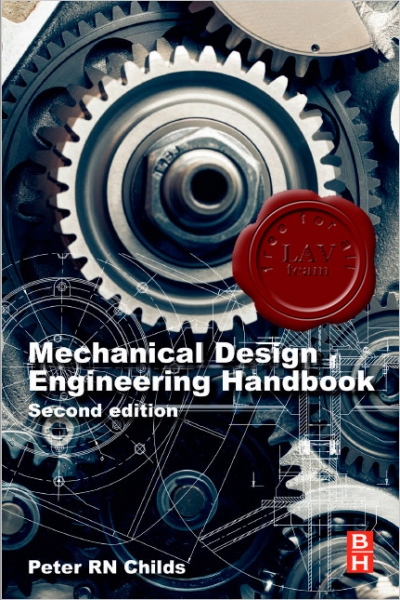
Mechanical Design Engineering Handbook, Second Edition, is a straight-talking and forward-thinking reference covering the design, specification, selection, use and integration of the machine elements that are fundamental to a wide range of engineering applications. This updated edition includes new material on tolerancing, alternative approaches to design, and robotics, as well as references to the latest ISO and US engineering regulations. Sections cover bearings, shafts, gears, seals, belts and chains, clutches and brakes, springs, fasteners, pneumatics and hydraulics, amongst other core mechanical elements. This practical handbook is an ideal shelf reference for those working in mechanical design across a variety of industries.
In addition, it is also a valuable learning resource for advanced students undertaking engineering design modules and projects as part of broader mechanical, aerospace, automotive and manufacturing programs.
Key Features:
- Presents a clear, concise text that explains key component technology, with step-by-step procedures, fully worked design scenarios, component images and cross-sectional line drawings.
- Provides essential data, equations and interactive ancillaries, including calculation spreadsheets, to inform decision-making, design evaluation and incorporation of components into overall designs.
- Includes procedures and methods that are covered to national and international standards where appropriate.
- New to this edition: flow-charts to help select technology; Failure Mode Effects Analysis (FMEA), product, service and system design models, Functional Analysis Diagrams (FADs), Design for Excellence (DFX), Design for MADE, and the process of remanufacture.
|
| |
 Читать статью дальше (комментариев - 8)
Читать статью дальше (комментариев - 8)
| |
|
 |
 Автор: Williams Автор: Williams
 Дата: 19 августа 2020 Дата: 19 августа 2020
 Просмотров: 3 025 Просмотров: 3 025 |
| |
Michael Lindeburg - Civil Engineering Reference Manual for the PE Exam, Fifteenth Edition
PPI, 2015
pdf, 1648 pages, english
ISBN-13: 9781591265085
ISBN-10: 1591265088
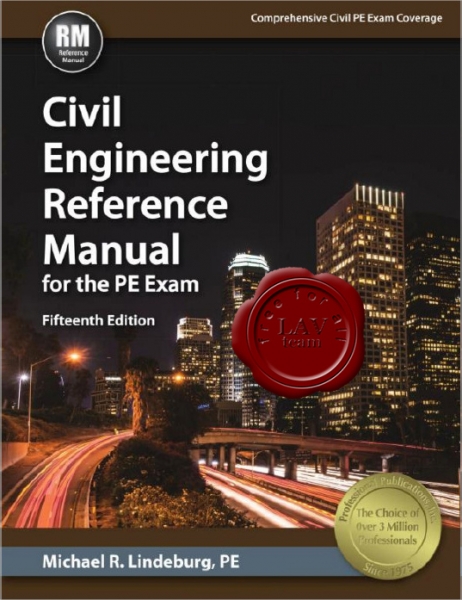
Since 1975, PPI has helped over 4 million engineers, architects, and designers achieve their licensure goals.
Comprehensive Civil PE Exam Coverage The Civil Engineering Reference Manual is the most comprehensive textbook for the NCEES Civil PE exam. This book's time-tested organization and clear explanations start with the basics to help you quickly get up to speed with common civil engineering concepts. Together, the 90 chapters provide an in-depth review of all of the topics, codes, and standards listed in the NCEES Civil PE specifications. The extensive index contains thousands of entries, with multiple entries included for each topic, so you can find the topics referenced no matter how you search. This book features: over 100 appendices containing essential support material over 500 clarifying examples over 550 common civil engineering terms defined in an easy-to-use glossary thousands of equations, figures, and tables industry-standard terminology and nomenclature equal support of U.S. customary and SI units After you pass your exam, the Civil Engineering Reference Manual will continue to serve as an invaluable reference throughout your civil engineering career. Exam Topics Covered Civil Breadth: Project Planning; Means and Methods; Soil Mechanics; Structural Mechanics; Hydraulics and Hydrology; Geometrics; Materials; Site Development Construction: Earthwork Construction and Layout; Estimating Quantities and Costs; Construction Operations and Methods; Scheduling; Material Quality Control and Production; Temporary Structures; Health and Safety. For additional Construction Depth coverage, check out the Construction Depth Reference Manual. Geotechnical Site Characterization; Soil Mechanics, Laboratory Testing, and Analysis; Field Materials Testing, Methods, and Safety; Earthquake Engineering and Dynamic Loads; Earth Structures; Groundwater and Seepa≥ Problematic Soil and Rock Conditions; Earth Retaining Structures; Shallow Foundations; Deep Foundations Structural: Analysis of Structures; Design and Details of Structures; Codes and Construction. For additional Structural coverage, check out the Structural Engineering Reference Manual . Transportation: Traffic Engineering; Horizontal Design; Vertical Design; Intersection Geometry; Roadside and Cross-Section Design; Signal Design; Traffic Control Design; Geotechnical and Pavement; Draina Alternatives Analysis. For additional Transportation Depth coverage, check out the Transportation Depth Reference Manual. Water Resources and Environmental: Analysis and Design; Hydraulics-Closed Conduit; Hydraulics-Open Channel; Hydrology; Groundwater and Wells; Wastewater Collection and Treatment; Water Quality; Drinking Water Distribution and Treatment; Engineering Economic Analysis. |
| |
 Читать статью дальше (комментариев - 19)
Читать статью дальше (комментариев - 19)
| |
|
 |
 Автор: Williams Автор: Williams
 Дата: 17 августа 2020 Дата: 17 августа 2020
 Просмотров: 6 188 Просмотров: 6 188 |
| |
Mustafa Mahamid, Edwin Gaylord, Charles Gaylord - Structural Engineering Handbook, Fifth Edition
McGraw Hill, 2020
pdf, 958 pages, english
ISBN: 978-1-26-011599-4
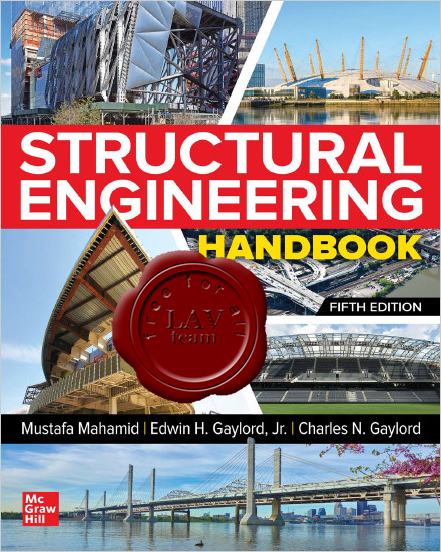
This Handbook is the industry-standard guide to structural engineering - fully updated for the latest advances and regulations.
For 50 years, this internationally renowned handbook has been the go-to reference for structural engineering specifications, codes, technologies, and procedures. Featuring contributions from a variety of experts, the book has been revised to align with the codes that govern structural design and materials, including IBC, ASCE 7, ASCE 37, ACI, AISC, AASHTO, NDS, and TMS. Concise, practical, and user-friendly, this one-of-a-kind resource contains real-world examples and detailed descriptions of today’s design methods.
Structural Engineering Handbook, Fifth Edition, covers:
- Computer applications in structural engineering.
- Earthquake engineering.
- Fatigue, brittle fracture, and lamellar tearing.
- Soil mechanics and foundations.
- Design of steel structural and composite members.
- Plastic design of steel frames.
- Design of cold-formed steel structural members.
- Design of aluminum structural members.
- Design of reinforced- and prestressed-concrete structural members.
- Masonry construction and timber structures.
- Arches and rigid frames.
- Bridges and girder boxes.
- Building design and considerations.
- Industrial and tall buildings.
- Thin-shell concrete structures
- Special structures and nonbuilding structures.
|
| |
 Читать статью дальше (комментариев - 35)
Читать статью дальше (комментариев - 35)
| |
|
 |
 Автор: Williams Автор: Williams
 Дата: 15 августа 2020 Дата: 15 августа 2020
 Просмотров: 1 557 Просмотров: 1 557 |
| |
K. L. Mittal, S. K. Panigrahi - Structural Adhesive Joints: Design, Analysis, and Testing
Wiley, 2020
pdf, 342 pages, english
ISBN: 978-1-119-73643-1
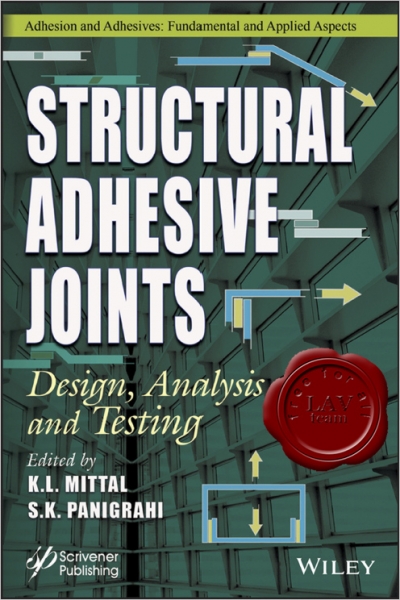
Most structures are comprised of a number of individual parts or components which have to be connected to form a system with integral load transmission path. The structural adhesive bonding represents one of the most enabling technologies to fabricate most complex structural configurations involving advanced materials (e.g. composites) for load-bearing applications. Quite recently there has been a lot of activity in harnessing nanotechnology (use of nanomaterials) in ameliorating the existing or devising better performing structural adhesives.
The 10 chapters by subject matter experts look at the following issues: surface preparation for structural adhesive joints SAJ, use of nanoparticles in enhancing performance of SAJ, optimization of SAJ, durability aspects of SAJ, debonding of SAJ, fracture mechanics of SAJ, failure analysis of SAJ, damage behavior in functionally graded SAJ, impact, shock and vibration characteristics of composites for SAJ, delamination arrest methods in SAJ. |
| |
 Читать статью дальше (комментариев - 10)
Читать статью дальше (комментариев - 10)
| |
|
 |
 Автор: Williams Автор: Williams
 Дата: 13 августа 2020 Дата: 13 августа 2020
 Просмотров: 1 581 Просмотров: 1 581 |
| |
Ronald Woods, Cameron Andres, Ronald Smith - Principles and Practices of Commercial Construction, Tenth Edition
Pearson, 2019
pdf, 561 pages, english
ISBN-13: 978-0-13-470466-1
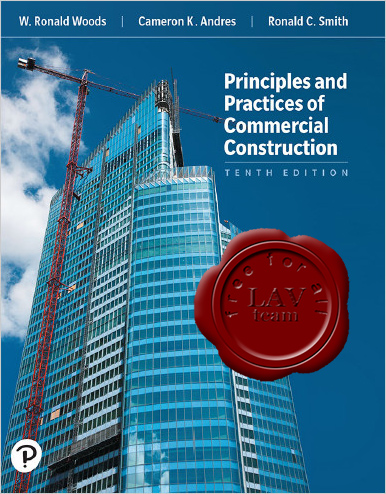
Principles and Practices of Commercial Construction teaches students how to apply design theory to the construction process, providing crucial working knowledge for contractors managing subcontractors. Progressing from basic to advanced material, the text appears on the approved reference list for numerous states requiring contractors to pass licensing exams. Its flexible organization gives instructors the option of teaching each chapter on a standalone basis in a range of construction, architecture, and engineering courses. The 10th edition expands its discussion of practical applications in structural design projects and adds practice opportunities preparing students for licensing exams. |
| |
 Читать статью дальше (комментариев - 6)
Читать статью дальше (комментариев - 6)
| |
|
 |
 Автор: Williams Автор: Williams
 Дата: 11 августа 2020 Дата: 11 августа 2020
 Просмотров: 2 381 Просмотров: 2 381 |
| |
Maribeth Price - Mastering ArcGIS Pro
McGraw Hill, 2020
pdf, 449 pages, english
ISBN: 978-1-260-58737-1
Although the concepts of GIS have remained fairly constant over time the software is continuallyevolving. With the release of ArcGIS Pro the latest software in the Esri GIS family a new generationof GIS has arrived. ArcGIS Pro has a 64-bit multithreaded architecture uses ribbon-stylemenus integrates 2D and 3D applications and is closely tied to ArcGIS Online.This text constitutes a major rewrite of Mastering ArcGIS a book that covered GIS conceptsand skills using the ArcGIS Desktop programs of ArcMap and ArcCatalog. Although the GISconcepts largely remain the same in both texts the implementation and in some cases theterminology has changed. |
| |
 Читать статью дальше (комментариев - 9)
Читать статью дальше (комментариев - 9)
| |
|
 |
 Автор: Williams Автор: Williams
 Дата: 9 августа 2020 Дата: 9 августа 2020
 Просмотров: 2 276 Просмотров: 2 276 |
| |
Tripp Corbin - Learning ArcGIS Pro 2, Second Edition
+ training files
Packt, 2020
pdf, 535 pages, english
ISBN: 978-1-83921-022-8
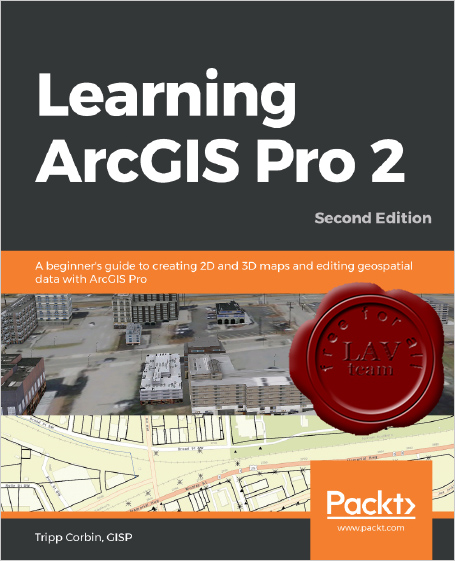
Armed with powerful tools to visualize, maintain, and analyze data, ArcGIS Pro 2 is Esri's newest desktop geographic information system (GIS) application that uses the modern ribbon interface and a 64-bit processor to make using GIS faster and more efficient. This second edition of Learning ArcGIS Pro will show you how you can use this powerful desktop GIS application to create maps, perform spatial analysis, and maintain data.
The book begins by showing you how to install ArcGIS and listing the software and hardware prerequisites. You’ll then understand the concept of named user licensing and learn how to navigate the new ribbon interface to leverage the power of ArcGIS Pro for managing geospatial data. Once you’ve got to grips with the new interface, you’ll build your first GIS project and understand how to use the different project resources available. The book shows you how to create 2D and 3D maps by adding layers and setting and managing the symbology and labeling. You’ll also discover how to use the analysis tool to visualize geospatial data. In later chapters, you’ll be introduced to Arcade, the new lightweight expression language for ArcGIS, and then advance to creating complex labels using Arcade expressions. Finally, you'll use Python scripts to automate and standardize tasks and models in ArcGIS Pro.
By the end of this ArcGIS Pro book, you’ll have developed the core skills needed for using ArcGIS Pro 2.x competently. |
| |
 Читать статью дальше (комментариев - 10)
Читать статью дальше (комментариев - 10)
| |
|
 |
 Автор: Williams Автор: Williams
 Дата: 7 августа 2020 Дата: 7 августа 2020
 Просмотров: 920 Просмотров: 920 |
| |
Timon Rabczuk, Jeong-Hoon Song, Xiaoying Zhuang, Cosmin Anitescu - Extended Finite Element and Meshfree Methods, First Edition
Academic Press, 2020
pdf, 629 pages, english
ISBN 978-0-12-814106-9
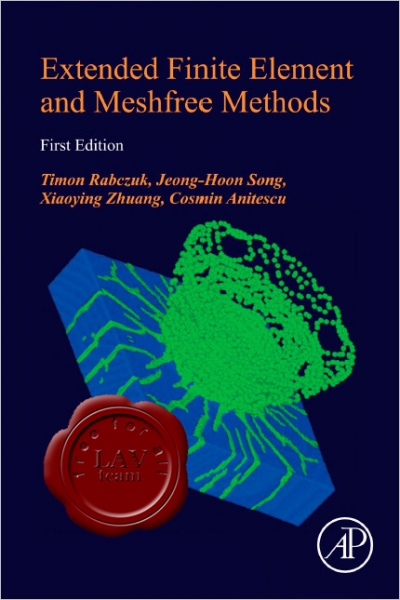
Extended Finite Element and Meshfree Methods provides an overview of, and investigates, recent developments in extended finite elements with a focus on applications to material failure in statics and dynamics. This class of methods is ideally suited for applications, such as crack propagation, two-phase flow, fluid-structure-interaction, optimization and inverse analysis because they do not require any remeshing. These methods include the original extended finite element method, smoothed extended finite element method (XFEM), phantom node method, extended meshfree methods, numerical manifold method and extended isogeometric analysis.
This book also addresses their implementation and provides small MATLAB codes on each sub-topic. Also discussed are the challenges and efficient algorithms for tracking the crack path which plays an important role for complex engineering applications.
- Explains all the important theory behind XFEM and meshfree methods.
- Provides advice on how to implement XFEM for a range of practical purposes, along with helpful MATLAB codes.
- Draws on the latest research to explore new topics, such as the applications of XFEM to shell formulations, and extended meshfree and extended isogeometric methods.
- Introduces alternative modeling methods to help readers decide what is most appropriate for their work.
|
| |
 Читать статью дальше (комментариев - 3)
Читать статью дальше (комментариев - 3)
| |
|
 |
 Автор: Williams Автор: Williams
 Дата: 5 августа 2020 Дата: 5 августа 2020
 Просмотров: 2 324 Просмотров: 2 324 |
| |
Wilpen Gorr, Kristen Kurland - GIS Tutorial 1 for ArcGIS Pro 2.4: A Platform Workbook (GIS Tutorials), 2 Edition
ESRI, 2020
epub, 702 pages, english
e-ISBN: 978-1-589-48590-7
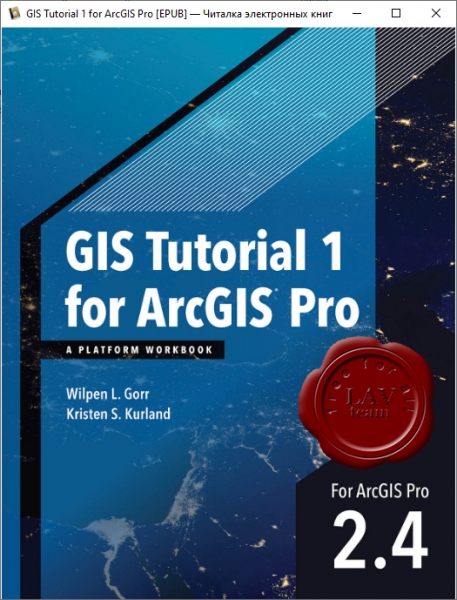
GIS Tutorial 1 for ArcGIS Pro: A Platform Workbook is an introductory text for learning ArcGIS Pro, the premier professional desktop GIS application. In-depth exercises that use ArcGIS Pro, ArcGIS Online, and other ArcGIS apps show readers how to make maps, how to create and analyze spatial data, and how to manage systems with GIS.
GIS Tutorial 1 for ArcGIS Pro: A Platform Workbook engages readers in:
- Obtaining spatial data and building a geodatabase for collecting, editing, and processing data.
- Exploring the functionalities of ArcGIS Pro, ArcGIS Online, and apps; understanding the elements of map design; and creating map layouts, story maps, dashboards, and 3D maps.
- Analyzing spatial data using buffers and street network-based service areas, locating facilities, and conducting cluster analysis.
- Automating GIS through macros for monitoring and optimal routing of service deliveries with data input in the field using a mobile app.
- Carrying out real-world applications for health care, crime, government services, planning, and marketing.
Incorporating proven teaching methods in detailed exercises, "Your Turn" sections, and expanded homework assignments, GIS Tutorial 1 for ArcGIS Pro: A Platform Workbook is suited to learning GIS in a classroom. Wilpen Gorr and Kristen Kurland have written the top-selling GIS Tutorial 1: Basic Workbook, GIS Tutorial for Health, and GIS Tutorial for Crime Analysis. |
| |
 Читать статью дальше (комментариев - 15)
Читать статью дальше (комментариев - 15)
| |
|
 |
| ПОИСК ПО САЙТУ |
 |
|
 |
|